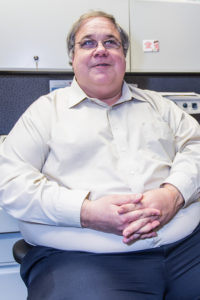Glenn McCully
How Six Months Became 23 Years
By Linda Norlen

Glenn McCully not only has the experience of a Lighthouse employee of 23 years, but also the larger perspective of a senior manager in Human Resources. Over the years, Glenn has gotten to observe the overall organization and witness the many changes that have taken place at The Lighthouse for the Blind, Inc.
When Glenn was hired in 1995, he was 28 years old and intended to stay for only six months as he made a transition to a new career. His first Lighthouse job in manufacturing paid just $6.05 per hour. But once inside the organization, Glenn realized that the Lighthouse offered more than he had previously thought.
At the time, the Lighthouse was mostly a manufacturing facility, “it had a family atmosphere,” Glenn recalls. Former CEO, George Jacobson walked the floor every morning; he knew everyone’s name and their family members’ names. But by the time George retired, this was no longer possible because the organization had grown too large.
In the ‘90s, the “direct” laborers in manufacturing were blind and so was the receptionist, but the other office “indirect” positions were all held by sighted people. Today 40-45 indirect positions are held by workers who are blind.
Glenn worked in employee resources even before the Lighthouse created a formal HR department in 2003. In the past, the orientation for new workers was minimal, however now there is an on-boarding program. New workers are taught the map of the building, as well as the routes to and from work and routes to places for their daily needs. Today, the Lighthouse continues to better serve people by providing programs that help their overall way of living. For example, the DeafBlind program emphasizes independent living skills and also offers an annual summer camp, allowing for opportunities to network and connect with others.
Increased efforts to reach out to the community is just one of the many changes that Glenn has seen at the Lighthouse. He also notes the upward mobility of people who are blind. When visitors come to the Lighthouse on a tour and see the jobs people can do without sight, they realize those who are blind can do many different jobs if given the right conditions. “There is no such thing as a cookie-cutter blind person,” says Glenn, especially when it comes to mobility. The more accessibility features are planned into the built environment, the better all people can benefit from them.
Glenn muses that in his long career he doesn’t know if he could have done as well elsewhere as he has at the Lighthouse. The organization also benefitted him in another way; it’s here he met his wife, Ursula. She had started working at the Lighthouse only a year after Glenn and they were always friendly, but then Ursula met a man from out of state, married him, and moved away. Only years later, after her divorce and return to Seattle, did she and Glenn become reacquainted—and eventually married. They’ve now been married ten years and are planning a cruise to Hawaii to celebrate.
Though Glenn jokes that “work” is still his biggest hobby, he also likes to travel. He’s been to Alaska a few times and always enjoys the conventions of the American Council of the Blind, which meet at a different U.S. city every summer.
Thinking about the past century of the Lighthouse, Glenn says that surviving 100 years is a milestone for the organization. Projecting into the future, he predicts advanced research on eye diseases could change things dramatically for the blind. Fifty years from now there may not be as many cases of blindness. But he thinks the Lighthouse will continue to provide value and will expand. Though manufacturing has been its past, today there are more service jobs being developed at the Lighthouse; future jobs will likely continue that trend toward services.